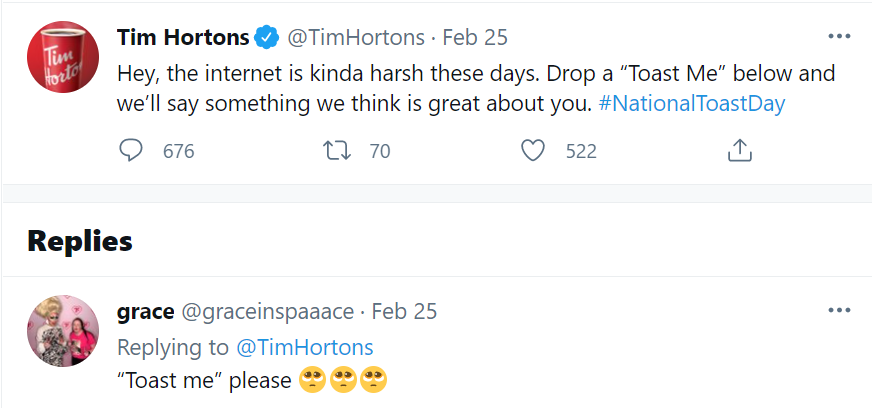
The week has started with a flurry of pretty heavy blog topics that have generated a great response from many of you – here in the “comments” section, as well as on my social accounts, especially on Facebook, Twitter, and LinkedIn. Topics like radio losing the battle for the ear, and the live and local debate are always great conversation starters.
I enjoy when JacoBLOG provides thought leadership, and stimulates big conversations that elicit a variety of opinions. But the programmer in me also senses when its time to play what we used to call a “relief record.” It’s like the slow dance that follows “Shout!” or the hora at weddings and Bar Mitzvahs. Sometimes, you just need to take it down a gear or two.
Today’s topic is a bit of a departure from some of the “heavyosity” of radio’s existential position in our post pandemic world, it is still an object lesson in branding and engagement.
So, let’s take a short road trip, grab a coffee and a donut at Tim Hortons, and kick back a bit.
If you’ve never had the pleasure, Tim’s is a Canadian institution that has made its way here in America, and in countries around the world. Tim Horton (singular) was an NHL player who made his way into the fast food industry in the 1960s.
Horton (singular) was an NHL player who made his way into the fast food industry in the 1960s.
Today, Tim Hortons (no apostrophe) is owned by Burger King, but still blessedly independent, with the freedom to build and nurture its own unique brand and spirit. There are more than 800 stores in America, and nearly 5,000 locations in 14 countries around the world.
But even with all that “hockey stick growth” over the last half century, Tim Hortons remains essentially Canadian.
And as Sprout Social’s Heliz Mazouri explains in a recent story – “How Tim Hortons puts people first in its social strategy” – there’s a method to Tim Hortons’ strategy and tactics that differentiates it from so many others in this highly competitive space where most customers want to get in, get out, and get going.
Here’s how the Tim Hortons team is doing it:
1. They have targeted a region – better yet, a mindset – Despite the chain’s rampant growth, they have never lost their Great White North roots. In fact, as Boshika Gupta explains in Mashed, “Tim Hortons is quintessentially Canadian.”
Their social team leans into the brand’s roots, with dishes like Poutine (fries and gravy) that aren’t available at McDonald’s or Arby’s. But it goes well beyond the menu items.
Tim Hortons social messaging is all Canada all the time. And as Mazouri points out, “They made an entire country their target audience.”
Cheers to great views & delicious brews☕️. #NiagaraFalls
📸: @safiaditya
Posted by Tim Hortons Cafe and Bake Shop on Saturday, January 23, 2021
That cultural connection goes to the heart of Tim Hortons’ relationship with its audience. Any radio station can do this too by leaning into what is truly Duluthian, Texan, or Detroitish.
In that way, embracing what is proprietary about a brand – the vibe, the spirit, the inside knowledge that a company “gets it” – is how one ALT station can be different from the 19 others with the same name (and perhaps even the same playlist).
2. They engage their customers – The social team curates playlists and acknowledges their fans and followers at all times on their channels.
You see it on their social feeds all the time. Yes, there are the customer complaints – orders not being filled correctly is a common gripe (ex: “You promised me you’d play that request”). But it’s their open, welcoming, and responsive spirit that sets Tim Hortons apart.

3. They let their customers create content – It’s one thing to come up with clever posts and missives. But Tim Hortons consistently shines the light on their fans, amplifying their brand.
And what do all Canadians share? Winter.
Tim Hortons’ holiday campaign last year showcased the “snow people” their fans made, rather than the products the chain sells. There’s very little product placement here. Their customers create the content, more authentic than any social marketing team could concoct.
We had the honour of featuring Canadians and their Snowpeople in our holiday film. We had the even greater honour of being able to see their reactions as they watched the final cut. Join us and witness the magic. Maybe it will inspire you to build your own! #SnowpeopleCanada pic.twitter.com/wivz4rfyls
— Tim Hortons (@TimHortons) December 23, 2020
This idea of saluting fans is something that great stations do – WDRV’s “Daily Driver” is a great example of making the average listener feel like she’s important.
Meet our friend Emily, a self-described proud Canadian and coffee lover. We recently chatted about her sweet license plate, epic Timmies road trips, and her favourite sights and stops during her travels. Check out her story at https://t.co/QswEUrAIjw pic.twitter.com/L60Ui06x84
— Tim Hortons (@TimHortons) March 31, 2021
4. They are empathetic – This is the most difficult of the Tim Tips, but it’s an important piece of their audience connectivity. It requires having a good Emotional IQ, and sensing when it’s time to pull back from the discounts, the sales, to BOGOs, and other promotions all brands offer to stimulate drive-thrus (cume).
Being in the moment, and knowing when an audience simply needs an encouraging word, a pat on the back, or an “atta girl” isn’t something you can teach. But program and social managers with great instincts have that ability, in the same way the Tim Hortons team is so good at walking a mile in the audience’s snow shoes.
We don’t know who needs to hear this right now, but you got this.
— Tim Hortons (@TimHortons) April 6, 2021
No pictures, no donuts, no coffee cups. Just elegant, simple, and authentic.
And as Toronto and much of Ontario are facing a heartbreaking COVID shutdown for the next four weeks, there is something personal and inspirational in their messaging. Right now, this is a message many Tim Hortons’ customers in Canada need to hear. So do the rest of us.
This reinforces the notion that while social media reaches a mass audience, and we all want our posts, videos, and GIFs to go viral, connecting in a one-to-one moment with an audience member is priceless.
That next cup of Tim Hortons coffee is on me.
- Media And Technology In 2025: Believe It Or Not! - April 18, 2025
- In Radio, You Just Never Know - April 17, 2025
- The Secret To Making A Great Podcast (And Great Radio) - April 16, 2025




Fred, my friend, you’ve brought a tear to this Canadian’s eye. Tim’s was a ubiquitous comfort when I had to leave Ontario for mornings in Winnipeg in winter conditions that were unspeakably cold. (Facenda Voice) “A glimpse of home in the frozen tundra.” “Timmie’s,” is the local community center in just about every Canadian neighborhood. They so get it and your allegory is solid. My motherland is on lockdown today. Can’t wait until they finally open the border and let me visit friends and family again, and yes, we’ll drop into Timmies. We always do.
So sad what’s happening in Ontario and Michigan. Things will get better, but “C’mon!” Thanks for this, and when the smoke clears, let’s hit a Tim’s soon.
So well said, both.
Fred, another great article about audience engagement. Radio tends to focus on what we’re doing, and we’ll never win the battle for hearts and eventually ears unless we focus on what’s really important to our listeners.
Exactly. Appreciate the kind words.
Great read Fred, user generated content is like the Mastercard commercial. It’s priceless.
Indeed, Jason. Thanks for the comment.
Add to this, Community Involvement and consistency. Yearly, the “Roll Up the Rim” contest gets people ripping up their coffee cups to see if they win a car or a donut … which generates endless social media posts. Tim Hortons Camp Day takes proceeds from that day to send kids to Summer Camp for a week. Both of those in pre Covid times. Their newest community involvement … and by new I mean it’s at least 10 years old … is smile cookies. By a cookie with a goofy smile on it, and a money goes to a LOCAL charity. Heck if your 4 year old is playing Timbits soccer, they get a free TImbit (donut hole) every time they go in wearing their jersey!
The coffee is terrible, and the donuts not nearly as good as they were when they were made on site every day, but rarely have the customers had to doubt where the franchise owners heart is.
Gosh darn it all to heck Fred, now I want a donut. Unfortunately I have no desire to turn on the radio. Can’t think of a damn thing really, for me, worth listening to. And I can stream any radio station on the globe. But a donut! Sweet, with a little bit of bite and chewiness and hopefully warm just out of the oven. I saw a tweet for a new station here in Austin called Lucy 933 earlier today, thought, oh yea, that’s one I haven’t heard, I should check it out. duck duck go’d it (notice I didn’t tune in) thinking, who the heck knows, Lucy is kinda a cool name for a radio station. The music….pop hits and flashbacks. Yea, not my thing. What about the hosts? Looks like syndication and voicetracks. What’s the point. click…. next….
John, you and I are WAY overdue for coffee and donuts. Meet halfway?
Sure, but that would be like Missouri or Southern Illinois. I do like Carbondale, nice little college town. Tried to corner you at the Radio Show in Austin a few years ago, but I was pretty busy writin’ up stories for Radio Ink. Next time.
On second thought, maybe we use Zoom.